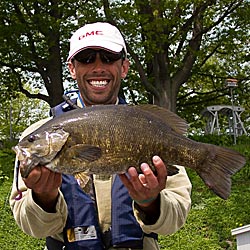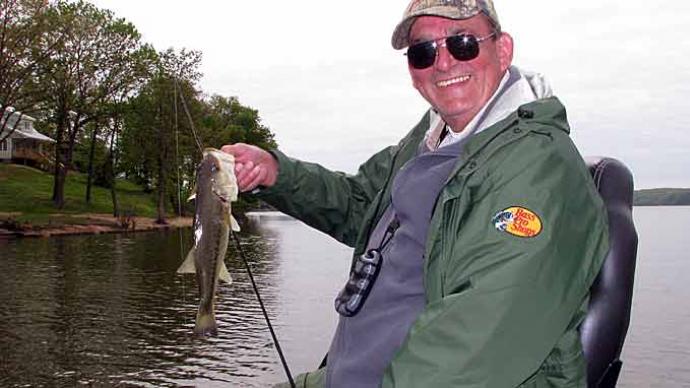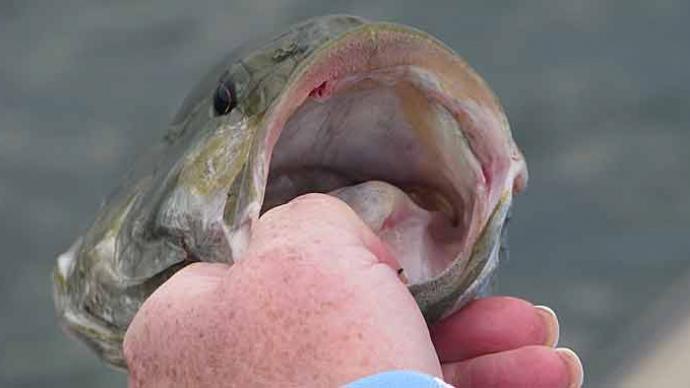
I know there have been volumes of information written about fishing the spawn – all reiterating the same things. Nothing addresses that one fish that won’t bite. You know the one who picks up your bait by the tip, being careful not to engulf the hook and lays it gently in the weeds outside the nesting site as if it were a piece of garbage. “I’m just cleaning the house,” is what I imagine that fish is thinking. I’ll give you one more tool to put this fish in the boat.
Drop shot. Drop shot? Isn’t that a deep water technique for catching finicky smallmouth? Yes, but if you begin to think of the drop shot as a terminal rig – a problem solver – you’ve opened new doors in your fishing experience. This technique will catch any bedding bass in shallow water. It involves stealth annoyance and capitalizes on some unique properties of the drop shot rig.
Often bed fishing is a simple toss your wacky worm, jig, or pegged creature bait into the nest enough times, that the fish eventually bites the whole bait, seemingly out of annoyance. But what about those days where they ignore everything, have seen everything, and flee the scene when you drop your bait, or just barely mouth it and move it.
This is where the drop shot rig comes into play. We can put those fish in the boat using an extended drop line, up to five feet or more, a heavyweight, and a barely sinking, snack-size bait. I don’t suggest starting with a drop shot as your first weapon. The fish will tell you when to use this by frustrating you to give up. Don’t give up. Be prepared. You gather information and develop your plan while “failing” with your favorite bed bait. Start noting where the fish puts your bait if it’s simply “cleaning house.” You will find many fish that will put that bait in the same spot every time. If the fish flees when you drop your bait there, stay and observe what direction they come from and where they face when they sit back on the bed. Often, this will take repeated casts. Don’t worry about over-pressuring or spooking the fish, and if they are locked on the bed, they’ll be back. You are just priming them for the catch.
Once you know where they put the bait or how they align themselves after fleeing, you will position yourself behind that point—time to grab the drop shot rig. I use a relatively stout medium power, extra-fast action spinning rod, spooled with 15 or 20 lb. braid, and an 8 lb. fluorocarbon leader. I attach a #1 or #2 drop shot hook with a Palomar knot, feeding the long tag end back through the top of the hook eye. Then attach a ¾ to 1-ounce tungsten cherry bomb style weight, about three to four feet below the hook. At first, this will feel awkward, but the heavyweight is crucial to the rig’s success. You’ll want to get some practice using underhand pitch casts with a spinning rod. You want to cast the weight just past the bedding area. If the weight lands in the bed, the fish will pick it up and move it.
At this point, your weight should be past the bed, leaving your line pointing right in the direction you determined earlier with your traditional bed bait. Your bait will be right in the middle of the bed, with a semi-tight line. I’m going to break off here and talk about baits. I won’t get specific with brands, but you want to use slightly heavier bait than neutrally buoyant when hooked. It should also be relatively small, 3-4” long, narrow, and with no appendages. There are a ton of worms that fit these criteria. Use your favorite in your favorite color. I like White Pearl, June bug, Motor Oil, and plain old Black.
Back to fishing…. You’ve made the perfect cast; your bait is centered in the “hot zone” of the bed. As in past attempts, the bass will usually pick up the bait and move it. Let it. Give it enough slack to move it and drop it. Wait a few seconds, and start to shimmy the bait in place, then make it rise back into the bass’s face. It may still just grab the tip and put the offending garbage back in a heap. Let it. Repeat the steps detailed above. Think about it. You just had your bait in the zone three times, on one cast! No other rigging allows this.

Eventually, you’ll see a different stance by the bass. It will be visibly agitated. You may see it engulf the bait. This is when you want to get ready to swing on it. Be careful, don’t swing too hard. It takes a wrist snap hook set to drive the tiny hook home with braid. Since you are in shallow water with sparse weeds and close enough to see the fish, you won’t have a prolonged battle and aren’t at risk of losing the fish. Keep the fish down, maintain control of its head, and be smiling for a snap of that trophy fish in no time.
I came up with this idea a few springs ago, fishing the spawn with my friend, Burnie Haney. Burnie had spotted a massive smallmouth on a bed, right at the inside corner of a dock and a break wall. He must have pitched his one-ounce pegged beaver rig in there ten times, each time whiffing on the hook set. Many beavers gave up their claws to that fish. As he was going through all of this, I noticed the fish depositing those claws in the same place. Then, I had the idea to use a drop shot for this fish. While Bernie took a break, I told him I had just what would get this fish to bite. One well-placed cast, and about 30 seconds later, I was yelling for Burnie to get the net. “You caught that on a drop shot?” Burnie said in amazement. That ended up being my best smallmouth of the year, a 5lb. 0 ounce. slab of brown fury. And many, many others since.
Perhaps Burnie would have eventually caught that fish. I like to think not. He had that fish primed with traditional bed baits, but the deal was sealed with an unconventional method. Try it this spring. I’m sure you’ll find it helpful when fishing for spawning bass is not the feast everyone makes it out to be.




